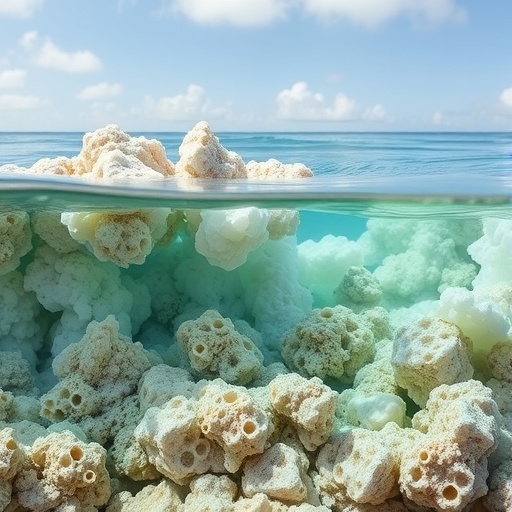Recent research has unveiled a remarkable connection between lithium isotopes and the intricate processes of silicate weathering that lead to the formation of authigenic carbonates in marine sediments. This groundbreaking study conducted by Huang, Gong, Peckmann, and their colleagues, published in Communications Earth & Environment, pushes the boundaries of our understanding of biogeochemical cycles in marine environments, shedding light on how these elements interact within sedimentary contexts. Understanding these relationships is not only essential for earth science but also has implications for climate studies and the management of carbon dioxide levels in our atmosphere.
The study begins with a thorough examination of the processes that govern silicate weathering. Silicate minerals, prevalent in the Earth’s crust, undergo weathering due to various environmental factors such as temperature, humidity, and biological activity. This weathering process releases essential nutrients into the ocean, fueling a series of ecological and geological responses. By analyzing lithium isotopes, the researchers illustrate how this element serves as a vital tracer, linking weathering processes to sedimentary carbonate formation.
Lithium isotopes are naturally occurring variants of the lithium element, distinguished by their differing atomic masses. The significance of these isotopes lies in their ability to monitor the weathering of rocks and subsequent carbonate precipitation. The research team utilized advanced isotopic measurements to identify variations in lithium concentrations in marine sediments, recording essential data that underscores the dynamic interactions between terrestrial input and marine sedimentation processes.
As sediments accumulate over geological timescales, the isotopic signatures of lithium can clarify the rates of carbonate formation and diagenesis—the transformation of sediment into rock. The research team’s findings reveal a distinct correlation between the degrees of silicate weathering in surrounding regions and the isotopic ratios observed within these marine sediments. This connection provides a window into past environmental conditions and facilitates predictions regarding sediment behavior under current climate scenarios.
Another vital component of the research is the exploration of authigenic carbonates. These minerals form in-place within the sediment, distinct from those transported from other locations. Authigenic carbonates are formed through complex chemical reactions involving dissolved ions, and they play a critical role in the carbon cycle by sequestering carbon in sedimentary environments. The study shows that the weathering of silicate rocks releases lithium, which contributes to the mineralogical and isotopic compositions of these carbonates, thus linking terrestrial weathering processes to marine sedimentology.
The implications of the research extend beyond geological insights. By understanding the intricate processes of lithium isotope fractionation, scientists can better comprehend how carbon is cycled through the Earth’s systems and how this knowledge affects current climate change scenarios. The role of authentic carbonates in sequestering carbon could provide pathways to mitigate rising atmospheric CO2 levels, offering a glimpse into potential strategies for climate intervention.
The collaboration of geochemists, sedimentologists, and climate scientists underscores the interdisciplinary nature of this research. By integrating methodologies from various scientific domains, the team has produced a comprehensive framework for understanding sedimentary processes, advancing our collective knowledge about the interplay between lithosphere and biosphere. Such collaborative approaches are pivotal for tackling complex environmental challenges that confront our planet today.
Moreover, the methodologies employed in the study are indicative of a new era in geological research. The utilization of high-resolution isotope analysis and advanced modeling techniques allows for greater precision in reconstructing past marine environments. These methods not only enhance the reliability of data interpretations but also enable a finer understanding of the temporal dynamics involved in sediment formation and alteration.
This research stands as a pivotal moment in the ongoing investigations of marine geochemistry. It pays homage to the foundational work of earlier scientists while paving the way for new avenues of inquiry. By unraveling the connections between terrestrial weathering, lithium isotopes, and authigenic carbonate formation, it stimulates fresh discussions regarding our planet’s changing environment and how past processes can inform future predictions.
Additionally, the study fosters a greater appreciation for the role of sedimentary environments in global biogeochemical cycles. Sediments serve not only as archives of past climatic conditions but also as active participants in ongoing geochemical processes. As climates continue to change, understanding these interactions becomes all the more critical in predicting the future state of marine ecosystems.
In summary, this research highlights the importance of lithium isotopes in tracing the influences of silicate weathering on marine sedimentary environments. The groundbreaking findings further elucidate the complexities of authigenic carbonate formation and challenge scientists to consider broader ecological implications within the context of climate change. As we strive to comprehend the past to prepare for the future, studies like this remind us of the delicate balance maintained within Earth’s natural systems.
The interrelationship between terrestrial processes and marine sedimentation is a testament to the intricacy of Earth’s systems. This research not only sheds light on the fundamental processes governing our planet’s evolution but also contributes to a larger dialogue on sustainability and environmental stewardship. As the global scientific community continues to grapple with the realities of climate change, delving deeper into these geological processes could hold the key to unlocking potential solutions.
In conclusion, the exploration of lithium isotopes in marine sediments presents a significant leap forward in our understanding of sedimentary processes and their implications for Earth’s carbon cycle. The collaborative efforts of researchers exemplified in this study highlight the essential role of interdisciplinary approaches in tackling pressing environmental questions, ensuring that science continues to lead the way towards a sustainable future.
By engaging with the intricacies of geological research, we invest in our understanding of the past and empower our efforts to shape a more resilient future for our planet.
Subject of Research: Connection between lithium isotopes and silicate weathering-driven authigenic carbonate formation.
Article Title: Lithium isotopes trace silicate weathering-driven authigenic carbonate formation in marine sediments.
Article References:
Huang, H., Gong, S., Peckmann, J. et al. Lithium isotopes trace silicate weathering-driven authigenic carbonate formation in marine sediments.
Commun Earth Environ 6, 787 (2025). https://doi.org/10.1038/s43247-025-02756-6
Image Credits: AI Generated
DOI: 10.1038/s43247-025-02756-6
Keywords: lithium isotopes, silicate weathering, authigenic carbonates, marine sediments, carbonate formation, biogeochemical cycles.




